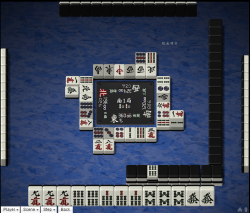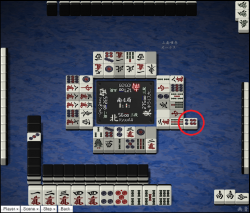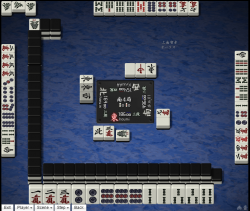Furiten: Difference between revisions
(add furiten japanese term) |
|||
| Line 6: | Line 6: | ||
To enforce furiten, the [[discard pile]] is specifically arranged in front of players and [[Naki|tile calls]] have one tile turned to indicate who discarded the tile. The discard arrangements allow players to keep track of who discarded which tiles. During a hand, players should take note of their status in relation to furiten and avoid calling winning hands while in furiten. Likewise, any calls for winning hands should have the discards checked for furiten. Any game involving software already checks for furiten, alerts players, and denies winning calls. | To enforce furiten, the [[discard pile]] is specifically arranged in front of players and [[Naki|tile calls]] have one tile turned to indicate who discarded the tile. The discard arrangements allow players to keep track of who discarded which tiles. During a hand, players should take note of their status in relation to furiten and avoid calling winning hands while in furiten. Likewise, any calls for winning hands should have the discards checked for furiten. Any game involving software already checks for furiten, alerts players, and denies winning calls. | ||
Furiten is translated as '''sacred discard''' in Chinese. In consequence, English terminology had made this the equivalent. However, this translation bears no relation to the Japanese term. | Furiten is translated as '''sacred discard''' in Chinese. In consequence, English terminology had made this the equivalent. However, this translation bears no relation to the Japanese term ({{kana|振り聴牌}}: thrown-away tenpai). | ||
== Rule statement == | == Rule statement == | ||
Revision as of 16:34, 27 September 2016

Furiten 「振聴」 is a game status where a player cannot declare ron because of a decision not to use a winning tile. A player in tenpai is furiten if any of that player's winning tiles are present in one's own discard pile or, in certain conditions, another player's discard pile or shouminkan. Players in furiten may still win by tsumo, but not by ron. A call of ron while furiten is penalized by chombo, although computer games will generally forbid the player from declaring a furiten ron.
In all cases, the furiten rule requires a player to be aware of all of their tile waits. If a player is tenpai but does not realize all of their possible waits, they may not be aware that they are furiten and, as a result, call an illegal win. This is especially true of a player who has called riichi, because they can be furiten off of anyone's discard for a long period of time.
To enforce furiten, the discard pile is specifically arranged in front of players and tile calls have one tile turned to indicate who discarded the tile. The discard arrangements allow players to keep track of who discarded which tiles. During a hand, players should take note of their status in relation to furiten and avoid calling winning hands while in furiten. Likewise, any calls for winning hands should have the discards checked for furiten. Any game involving software already checks for furiten, alerts players, and denies winning calls.
Furiten is translated as sacred discard in Chinese. In consequence, English terminology had made this the equivalent. However, this translation bears no relation to the Japanese term (「振り聴牌」: thrown-away tenpai).
Rule statement
A player in tenpai is in furiten in any of the following scenarios:
- They have discarded, at any point in the hand, one of their winning tiles.
- They are not in riichi; since their last turn, another player either discarded or made a shouminkan of one of their winning tiles; and they did not call ron on that tile.
- They are in riichi; since they declared riichi, another player either discarded or made a shouminkan of one of their winning tiles; and they did not call ron on that tile.
When evaluating furiten, yaku are not taken into account. A player may find themselves in a situation where they are forced to discard or pass on a tile that does not give them a yaku, but would otherwise have completed their hand. This will lead to furiten.
A player who is in furiten cannot call ron, although they can still call tsumo or make any other legal play.
Own discard furiten
When a player is in furiten because of their own discard, it is sometimes called permanent furiten. This name is slightly misleading because a player can (unless they have declared riichi) change their waits to avoid this form of furiten.
All of a player's discards can be checked at any time during play, by looking at their discard pools and the rotated tiles in other players' tile calls. This leads to the most basic strategy to avoid dealing into a player's hand: tiles they have already discarded are guaranteed safe against a ron call from that player.
During hand development, it is important to bear furiten in mind. Most of the time, if a hand gets to tenpai and is furiten at that point, it indicates that the hand was inefficiently developed. This is not always the case, as sometimes a player makes a tactically correct decision and finds themselves in furiten anyway.
The most common reason for furiten, however, is when a player is already tenpai with an open hand, and does not have a guaranteed yaku. While they may have a winning tile that provides them with a yaku, if that draw another tile which completes the hand without a yaku, then they will be forced into furiten on the next discard. This most commonly occurs with a shanpon wait, one pair of which would give yakuhai, or with a ryanmen wait on 14 or 69 on a hand that would otherwise complete tanyao.
Finally, a player considering a double riichi should carefully inspect their hand before discarding; if they had a complete hand to begin with, then being in furiten will add insult to the injury of having [passed] on a tenhou or chiihou tsumo.
Example tenpai hand
This hand waits on three different tiles. If the player has a 2-pin their discard pile, then the hand is in furiten and may not win by ron on any tile. Even if a 5-pin or 8-pin gets discarded by an opponent, ron may not be called.
Temporary furiten

Any player in tenpai has the option to ignore a winning tile. By declining a call for ron, the player then becomes temporarily furiten until their next discard. This is called temporary furiten, as it expires shortly after it occurs. Although most of the time, it will apply to a discarded tile, it can also apply to a tile used to create a shouminkan. Temporary furiten cannot apply to a tile used to create an ankan, as if a player can call ron on an ankan, then they have a single-sided kokushi musou wait (and even then, this is not permitted in all rulesets). If they decline a ron, then their hand is dead and cannot be completed.
The primary purpose of the rule is to prevent a player from targeting a later player in the turn order. Once a player sees a tile discarded, they know that they can follow with the same tile and it will be safe.
While this is often a mistake to enter temporary furiten, done by a player who does not know their waits correctly or is not paying attention, it may be done deliberately in order to achieve a higher scoring hand or to target a specific player. This becomes much more common in orasu, where a player may gain little benefit from winning a hand that does not let them pass another player. Temporary furiten can also be entered by a player who does not have a guaranteed yaku, as described above. This is much less devastating than drawing the yasume tile, however, because it is only temporary.
Uncommonly, some rulesets vary the rules by allowing a tile call made by another player to cancel temporary furiten. This variation is considered by many to be a poor one.
Permanent furiten during riichi

When a player has declared riichi, the state of temporary furiten does not expire for them. This means that they only have one opportunity to call ron; if they pass on it, then they can thereafter only win by tsumo. This rule is a critical part of defense against riichi, as it means that any tiles discarded since the declaration is safe.
The rule for riichi can be understood as saying that temporary furiten expires the next time the player has an opportunity to change their hand. Because a player in riichi cannot change their hand, their temporary furiten never expires.
A player in riichi never has to worry about yasume putting them in furiten unless they are playing with ryanhan shibari. When ryanhan shibari, a riichi without a guaranteed second yaku may be quite dangerous due to furiten.
Strategy
Defense
The furiten rule may be applied for defensive play, which focuses on discarding safe tiles. By discarding tiles that are also visible in an opponent's discard pile, a player can avoid a ron call by that opponent. Likewise, usage of suji and kabe may also help players deduce safe tiles, based on opponent discard. This is applied when a player does not have any matching tiles in the hand with opponent discard; or a player may rather keep certain tiles, for the sake of developing the hand without tearing it apart.
Working with furiten
Sometimes, it may be necessary to deliberately place the hand in furiten. Often, this is the result of developing the hand and defending simultaneously. To escape the bind applied by furiten, then the hand's tile wait(s) must simply change by adjusting and changing the tiles in the hand with subsequent tile draws. Of course, a player may place greater expectation on tsumo to win rather than ron.
Furiten tsumo
Hands in furiten can still win, as furiten imposes a limit of tsumo only. For open hands, the hand requires a valid yaku. For closed hands, mentsumo will be acceptable or added.
External links
- Furiten in Japanese Wikipedia